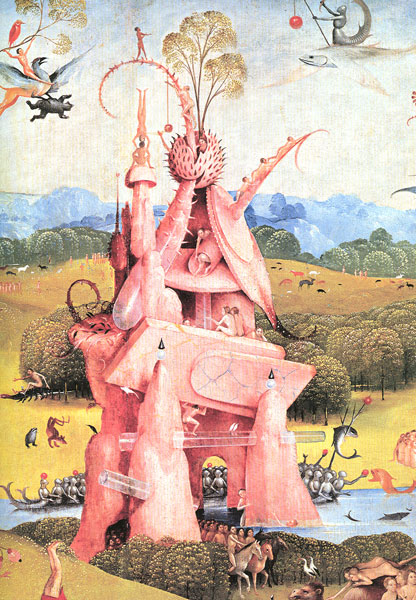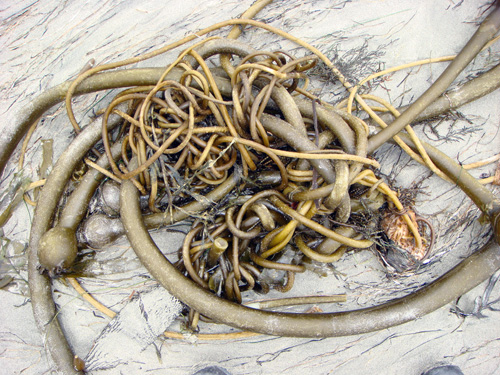I’m just writing a scene where the Peng make themselves a tulpa house that’s a copy of this structure from Heironymus Bosch’s Garden of Earthly Delights. Thuy gets them to do it for a joke; not being mammals the Peng don’t get it about those two pink towers near the top left, flaccid and turgid.

I’ll be off-line for the rest of June. Meanwhile, here’s some more pictures from Big Sur, along with notes about “matter hologram” tulpa bodies. If you wonder about the made-up words I use, just type them into the blog’s Search box at the top right, press Enter, and you’ll find links to earlier blog entries where I discussed these same words before and perhaps even defined them.

When Charlie Stross writes about sending people as info patterns—like in Glass House—he has a nanotech gate at the targeted location, which builds the incoming person’s body atom-by-atom (after first editing or “redacting” the incoming info pattern, for security’s sake). Let’s call this the nanoLego model of body transmission.

For Hylozoic, I’m proposing a much more baroque way of having the Peng be sent. Their pattern is sent to Earth, same as in the nanoLego method—but then instead of building them a body, I have their info coded into a quadrillion-fold inefficient Peng ranch computation of slaved atoms spitting out paired-fermion De Broglie waves to create a matter hologram of a Peng, said hologram being dynamically updated by the distributed computation.

I’m not doing this because I think it’s more realistic or likely. I’m doing it for exiguous reasons, that is, I want to write a story where aliens are skimming off the gnarl of our natural computations. And it occurred to me that if aliens were going to be mulcting us of our gnarl, they should be using it for something important to them, and what could be more important to them than projecting copies of themselves into our world.

But in the story there has to be an internal motivation for the Peng going all around Robin Hood’s barn like this. If I don’t explain why they’re not using the easier nanoLego method, I’ll seem like I’m foolishly overcomplicating things.
So—let’s address this question in the novel, and claim that being in a tulpa matter hologram body is much better than being in a normal nanoLego solid matter body.
Better how?

Weak answer: it’s a luxury for the Peng to get such obscenely inefficient bodies. Like driving very fuel inefficient cars. Conspicuous consumption. “Oh dear, my body uses a quadrillion times as many atoms as your body. But, ahem, I can afford to.”

Better answer: A tulpa body is very hard to destroy, as it emerges from a million cubic kilometer computation. So it’s a safer body to have on a world with possibly hostile natives. Fine, but we could argue that a nanoLego body could pretty easily be reconstituted , so we need a stronger reason than this.

Best answer: a tulpa matter-hologram body has femtotech powers, which seem like superpowers. If you’re an ioneer in a tulpa body, then you yourself, qua epiphenomenon of a distributed quantum computation, are able to tweak your underlying computation—which fills the million cubic kilometers of Peng ranch surrounding you. Therefore you have telepathic direct matter control, that is, your thoughts can become objects—which are additional matter holograms that (at least as seen from the outside) behave just like normal nanoLego objects. You can build a house from nothing, turn a stone into bread, water into wine, make flowers bloom from your fingertips. You can levitate and move your body around as readily as a video game player moves Mario. (I won’t allow for teleportation though, not even within the volume of the Peng ranch, as, for story purposes, I’m limiting full teleportation power to humanoids.) You can shapeshift and change your form. Perhaps the Peng begin looking like—the horror!—human Realtors. “Call me Ducky. What would it take to earn your business today?”

By virtue of having installed all the tulpaware atom by atom on the Peng ranches, Jayjay could have lasting mental indices of the atoms in both the wilderness and the SF Peng ranches. This data could be stored in his endless lazy eight memory upgrade. But I’ll he didn’t pay close attention. He didn’t bother to remember.
But maybe Chu finds out the atomic programming by watching the Peng tulpas make themselves a tulpa house.

Jay—and he alone of all humans—does know the general mediumistic tulpa-programming technique, so with Chu’s memory help, Jayjay is able to reach out to each and every one of the atoms and put something else into it. Call this antidote the aether wind. It’s about “dusting off” the atoms, decohering them from the unitary quantum state that’s generating the tulpas. It should take our two boys a couple of minutes to psychically blow a puff of aether wind onto each and every atom of a Peng ranch

The Peng ioneers try to kill Jayjay and Chu while they’re decohering their Peng ranch atoms with the aether wind. They’re freeing the silps concentrically from around his house, so they’ll have rings of allies around. For their part, the ioneers are getting telepathic control of some of the low-gnarl animal minds, such as bears and mountain lions. And Gretta shapeshifts into a human woman Realtor to trick the boys.

But then the Peng (and the Realtor) start looking weird. They’re partial series sums now, what mathematicians call “jets”. This means both that the Peng tulpas each have a half dozen ghost images, and that their shapes are overly smooth in spots and with odd sharp cusps in other places. Their thoughts are a bit incoherent as well.

Kakar turns the aether wind back upon Jayjay, decohering his particles effectively pausing his quantum computation in mid-crunch. Jayjay is frozen in the midst of saying something to Thuy—a little like when Han Solo became a silvery sculpture on Jabba the Hutt’s wall.









June 12th, 2007 at 10:08 am
Hey Rudy. Cool post!!
This is so fun to read. I wrote a folk novel
in highschool about 1984 which had a character
with similiar powers. Megiddo.
Suddenly turning yourself into animate gold
growing arrays of squid nozzles
and propulsiing away on torrents of black pearls
filling an entire city with hot molten licorice etc..
the way i did it was like a dimensional
venturi, like a materio voltaic potential
the computation assembly is in a separate dimension as well . it’s a multi-dimensional circuit. the computational dimension has an entire dimension
to use as “paint”
and the computation then is like a trans-dimensional nozzle..
I like the idea of being able to generate and then
initialize infinite dimensions like you would a series
of floppy discs.
or even bundling dimensions into “eternity-packets”
for growing mythscape resort hideaways via
heavy “di-fi”
hyperpowerful chymeras!
i hope your book does well!
thanks
Lanny
June 12th, 2007 at 11:06 am
Rudy, another Latin tag appropriate for someone who hikes and communes with nature to combat writer’s block:
Solvitur ambulando
(The problem is solved by walking around)
July 3rd, 2007 at 10:26 am
Hey, Rudy? How about a new post – it’s been almost a month. Hope all’s well and you’re enjoying your summer.
Your writing is always thought provoking. Cheers.
July 4th, 2007 at 3:44 am
Where are you!?
July 4th, 2007 at 10:09 am
I’m in France, and I’ll be home and blogging again by this weekend. I was here with my wife to take a painting workshop; we did some nice stuff.
Happy Fourth of July, mes amis americaines…